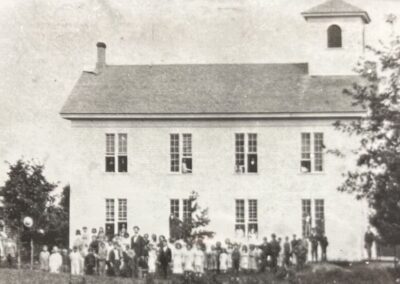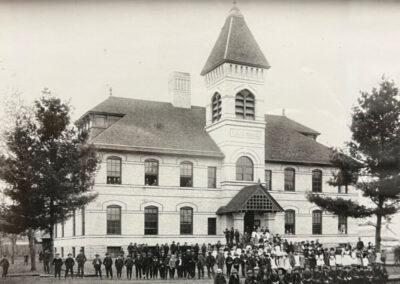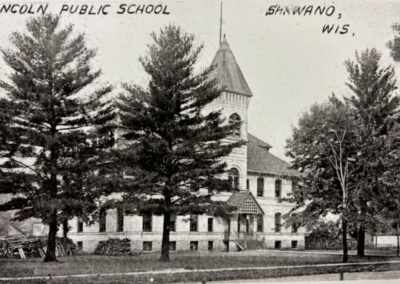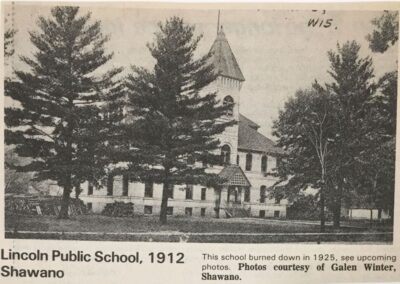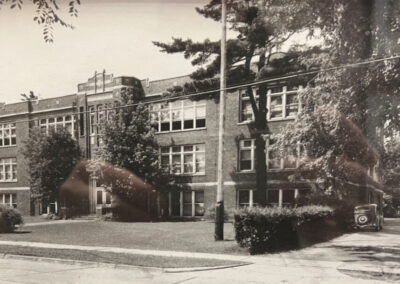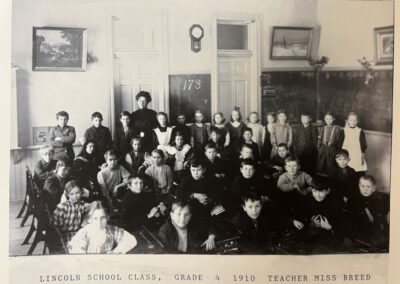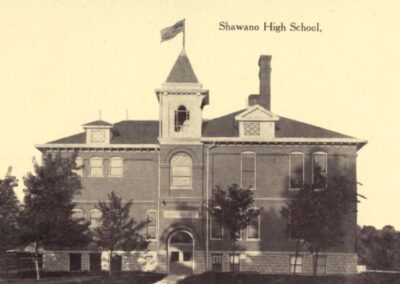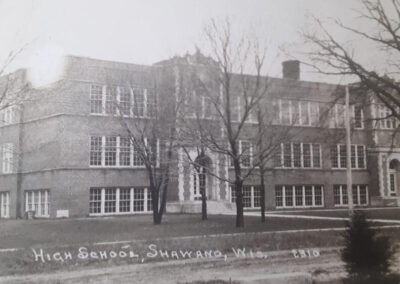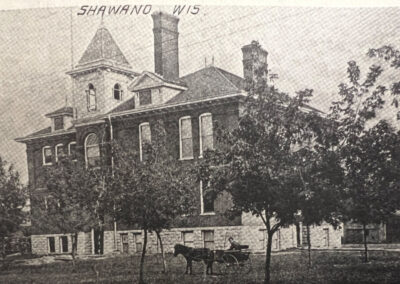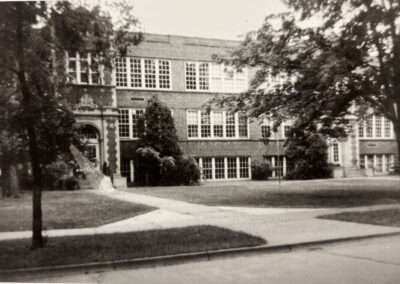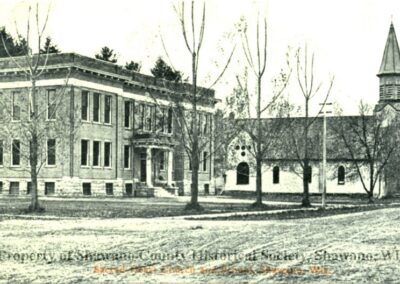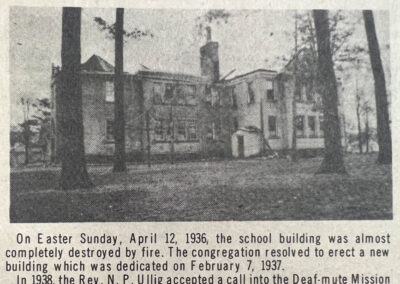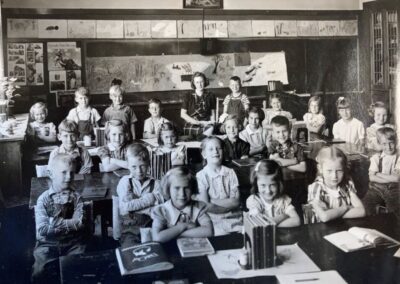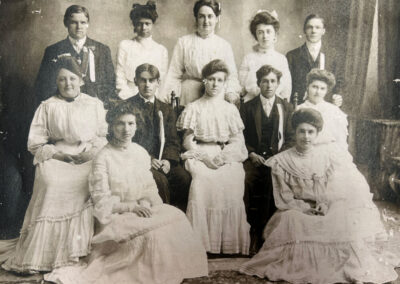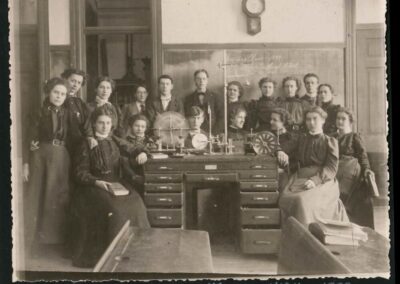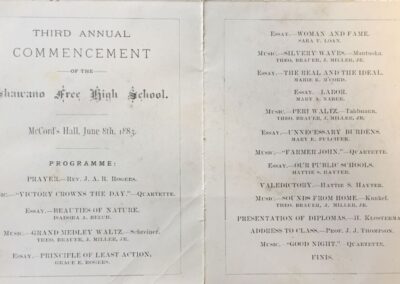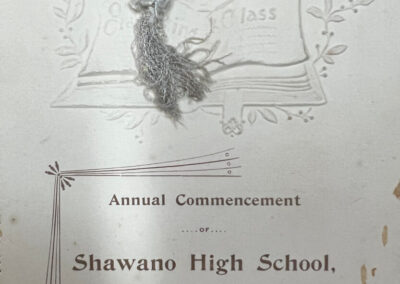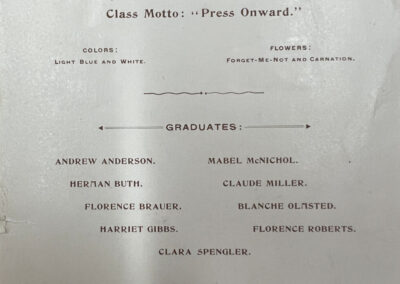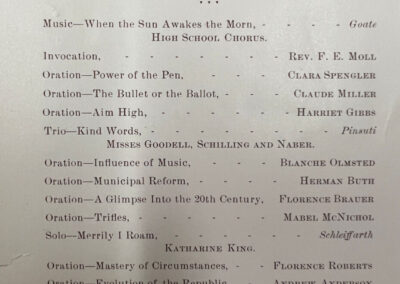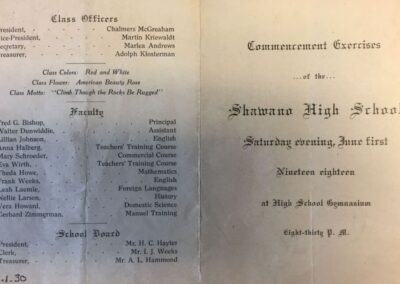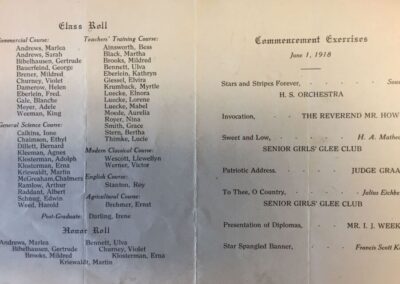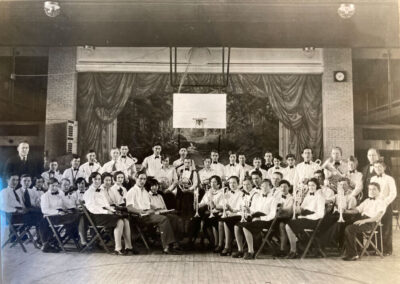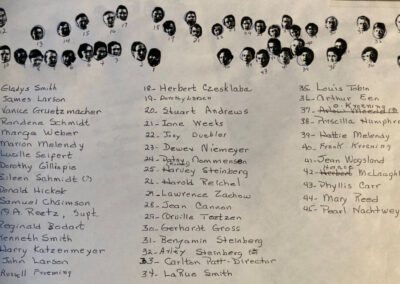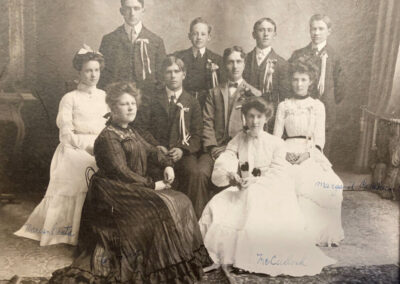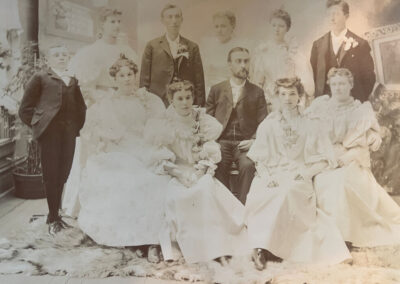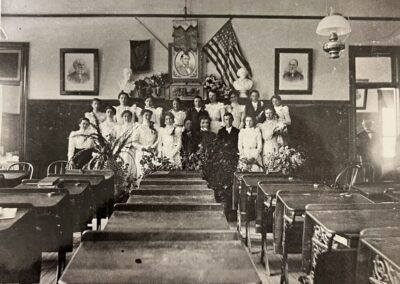Photo Gallery
Lincoln School, grade 1 – unfortunately, we don’t have a date for this photo. Back row: Desneige Ellefsin, unknown, unknown, Richard Thomas, Teacher – Miss Larsen, Richard Sauer, Donna Krueger, Zandoa Curtain, Joan Lang. Middle row: unknown, Mary Ann Krause, Marie Swansen, Illa Schoening, Connie Weinig, Gene Dahse, Carleine Schreiber Front row: Roger Schwekner, Gordon Shannon, Gloria Vomastic, Betty Lou Clark, unknown, Marla ??
Shawano High School graduating class of 1905 – Back row: Athol Kuckuk, Sara Pendelton, Miss Donelly (Latin), Edna Weigam, Frank Ackerman Middle row: Mayme Pulcifer Wittke, Ken Partlow, Hazel Schweers, Will Leisch, Sara King Front row: Clara Barkow and Hazel Kathan.
The Shawano High School graduating class of 1904 – Top row left to right: Walter Schmidt, Erving Miller, Joe Rutte, Walter Lusch, Oscar Reschke, Bernard Naber. Ladies: Marion Banta, Evans, McCulloch, and Margaret Calahan.
From 1895, one of the earliest Shawano High School graduation photos we have at the Shawano Country Historical Society. Back row: Andrew Anderson, Hattie Gibbs, Herman Buth, Miss Goodill, Clara Spengler, Claude Miller Front row: Florence Roberts, Mabel McNichol, Prof. D.O. Williams, Florence Brauer, Blanche Olmsted.
Schools In The City Of Shawano
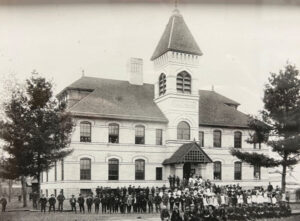
LINCOLN SCHOOL
Lincoln School is significant in the development of the Shawano school system because it was the first school built for the purpose of educating students after Shawano incorporated as a village in 1871. Before this, there were rural schools but no organized school system. There have been three schools where the current Lincoln School is located on Sawyer Street and all have been named, Lincoln School.
The first public Lincoln School building was constructed on the present Lincoln school site in 1871, and used as a school until 1887. This first school was a wooden two story building consisting of two rooms and a recitation room. Caroline Magee was the first teacher. The building was later moved to Main Street so a new school could be built. Later it was moved to South Main, next to The Farmers Brewery, where it was used as a furniture store but was torn down in 1990.
In 1887, a new brick building was built to replace the old Lincoln School at a cost of $8,000. Along with elementary classes, the high school remained in Lincoln School until 1902 when a separate high school was built. The second Lincoln School was destroyed by fire in 1924. Fire was a common occurrence in schools at this time.
The following is a description of that fire taken from the Shawano County Advocate (March 4, 1924):
At about two o’clock Friday morning the fire alarm sounded and it was soon learned that it was the Lincoln school building. Some neighbors living near first saw a fire in the northeast corner of the building and gave the alarm . . . It was fifteen or twenty minutes before the fire fighters got to work as they could not get a team or truck to take the hose cart over to the school building . . . The fire spread rapidly. It was thought that the new addition might be saved and the fire department had a number of streams on the building within a short time, but the fire had too good a start and not a thing was saved from the entire building. We have been informed that the insurance on the building is $36,400 as the loss was total.
In 1925, a third Lincoln School was built on the same site. It cost approximately $130,000 and was considered, at that time, to be one of the “most up-to-date school buildings in any city in Wisconsin.” The fire that destroyed the original Lincoln School in 1924 presented city leaders with an opportunity to expand their approach to education. They planned a school that would serve children from kindergarten through eighth grade in the burgeoning progressive model.
The 1925 Lincoln School, designed in the Collegiate Gothic style, embodied the most current philosophies in education and school design at the time it was built. Educators believed in a diverse curriculum that would provide children with a broad foundation of knowledge and skills. To foster these goals, school buildings were designed with specialized spaces including a library, manual training and domestic science rooms, and a gymnasium with shower rooms. The architectural firm of Parkinson and Dockendorff, a specialist in modern school design, created a school with modern amenities such as central heating, electricity and indoor plumbing. Classrooms were large and expansive windows provided abundant natural light and ventilation. Perhaps most charming is the kindergarten classroom, which in an effort to project a home-like environment for very small children, included a fireplace and built-in window seats around a large bay window.
The Lincoln School is the oldest surviving school building in Shawano, and is the only remaining school building constructed in the city prior to World War II. The building served as the district elementary school until 2011 when it was sold and developed into apartments.
Lincoln School, located at 237 South Sawyer Street in Shawano, Wisconsin was listed on the National and State Historic Registers in 2013.

FRANKLIN SCHOOL
In 1876, Shawano was granted a city charter and the city fathers, led by Henry Nabor and L.D. Roberts, saw as one of their major responsibilities the development of a 1-12 grade school system. In 1879, they began formalizing Shawano’s educational system. In that year, on July 14th, the Shawano City School District was officially created by the State of Wisconsin. However, it was under the jurisdiction of the county superintendent until 1920, when its own superintendent of schools position was created.
The first high school classes were held in the second floor of the McCord Building (corner of Main and Green Bay Street) in 1878. The hall was rented for classrooms at five dollars per month. The balance of the upstairs was used as an opera house, a skating rink, and a general meeting place, while the downstairs was a general store. Thirty-one young people applied for admission as students; twenty-nine passed the admission examination, two failed.
L.D. Roberts was chosen as the first principal of the district which included grades 1 – 12. The first high school class graduated in 1881. There were four graduates that year: Edward Farnsworth, George Martin, Clarence Mann, and Marietta Munn.
Soon the number of students outgrew the building and the facilities proved inadequate. The high school was then moved to Lincoln School. The upper half of the building became the high school and the lower half the grade school.
In 1887, a new brick building was built to replace the old Lincoln School at a cost of $8,000. The high school remained here until 1902 when a separate high school was built.
In 1902, because of increased enrollment in both elementary and high school, it was decided to build a separate high school. It was built on the corner of Franklin and Presbyterian Streets. This remained as the high school until 1916. It was vacant after that and was finally torn down in 1932. In 1917, a new building was built just to the north of the high school and it was named, Franklin School.
Below is part of an article from the Shawano County Advocate (March 3, 1917) which describes this new $100,000 high school.
The new high school will be one of the most complete in northern Wisconsin and many new conveniences not found in other schools have been installed. The main part of the building is 154 by 160 but this is not solid as it is built in a T shape. The exterior is dark red with white mortar and looks attractive. The stone work gets the building off in nice shape. There are practically three stories to the building, the basement and two other floors, but the basement being all above ground makes it light as any of the other floors.
On the south side of the basement the manual training department will be situated, and the rooms will consist of a drawing room, bench room, stock room and a small room for the instructor . . . On the other side of the basement is the domestic science department. On the first floor will be the principal’s office commercial and typewriting rooms and one or two recitation rooms. The second floor will be found the large auditorium.
Many at first glance do not like the looks of the small windows in the building, but it is said that all of the modern school buildings are built that way at the present time, claiming that the small glass is much better accustomed for school purposes.
In 1933, an addition was built to the high school. This was a PWA project when the gymnasium was extended to Washington Street. Two new classrooms on the second floor and new shower rooms were also installed. Two stories were also built over the boiler room. In 1958, there were other improvements. The main study hall was shortened to provide for a library and two classrooms. Another addition was completed in 1963. This included a suite of offices for Joint District #8, the Board of Education room, office and supply room for the superintendent, kitchen and cafeteria, two guidance offices, three classrooms and a music room.
Beginning in the 1940’s the State of Wisconsin began the movement to consolidate the rural and urban schools. In 1948, Shawano became a part of this process. Shawano and surrounding rural grade schools became Joint District No. 8. The new district included 22 branch schools and two central schools — Gresham and Shawano. District No. 8 became one of the largest integrated school districts in the State of Wisconsin. It had an enrollment of 2300 students and a teaching staff of over 100.
The school board realized with the increased enrollment; a new high school would have to be built. After much discussion and investigation they made this recommendation. On July 11, 1953, after the need for a new school had been stressed repeatedly in the newspapers, over the radio, and at public meetings, the citizens voted to bond the district $725,000.
On September 1st, the site was chosen by the electors. According to the sketches prepared by the architect, the new school would include a practice football field, a half-mile track, parking lot, three softball diamonds, one baseball diamond, five tennis courts, and sheltered bus loading facilities next to the building.
Construction was started in the spring of 1954 and in 1955, the high school was moved to the new school on Union Street which was made up of grades 10-12. In 1968, the ninth grade was moved to the high school and Franklin Junior High became Franklin Middle School, included grades six, seven and eight. With the construction of a new high school, the middle school was moved to the “old” high school on Union Street and Franklin School was left vacant and razed in 1998. Today, the block has been transformed into Franklin Park.
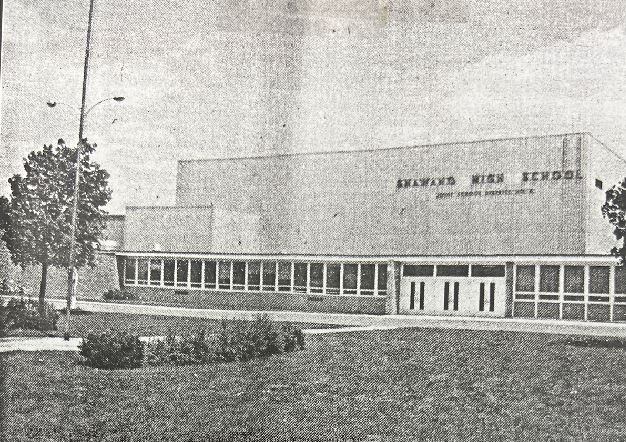
SHAWANO HIGH SCHOOL
Plans for Shawano’s Senior High School were made in 1954 with the pur-base of 27 acres of property in southeast Shawano. Nick Cupery was the superintendent of School with Dr. W. HI. Cantwell, president of the Board of education. A. W. Gast was treasurer of the board at the time, Fenton Muehl was the clerk and other members who served were Mrs. Lucille Mayhew, Mrs. Ruth Meyer, Walter Wolf, Victor Sousek, Al Prey and Everett Gueths.
The school was built at a cost of $875,000. This also included the fixtures and furniture. Classes began in the fall of 1955, before the gymnasium or the cafeteria were completed. There were about 600 students, 26 teachers and 173 graduates that year. Harold Stewart, who came to Shawano as superintendent of school of District 8 in 1955, saw the building completed. Mr. Stewart made application for Shawano High School to become a North Central School. He, with the assistance of Principal E. F. Thomas, and his faculty, made the plans.
Shawano High School was accepted into the North Central Association in 1958. Due to the increased enrollment in 1962, it was necessary to add five more teaching stations to the then twenty four stations. This was done at a cost of $141,900. The school housed 799 students and 35 teachers. Funds were provided by the Federal Government. At the 1964 commencement, 212 seniors were graduated. In 1974 a total of 219 graduated for the 94th annual commencement. Mr. Muellenbach moved to the Central office in 1968 and was succeeded as principal by Carl Carmichael.
In 1968 another addition was added to the high school. The bonds on the original building were burned at a ceremony on May 16, 1974.
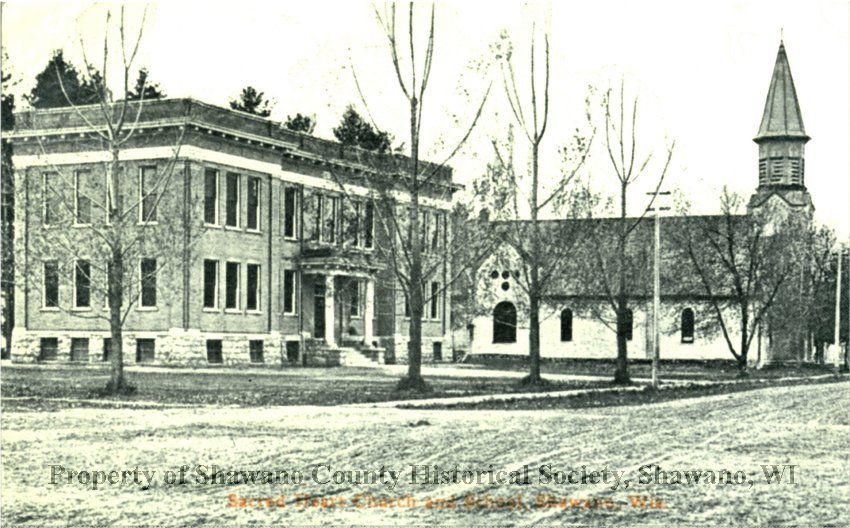
SACRED HEART CATHOLIC SCHOOL
The first building known as Sacred Heart School was a two-story white frame building purchased by Sacred Heart Parish in 1881 from the Shawano Public School System. The wooden structure was the former Lincoln School. The Parish purchased it for $550 and it was moved across Center Street to the present Sacred Heart location. At the request of Reverend Vincent Halbfus, Provincial of the Franciscan Fathers of St. Louis, who were then in charge of the Catholic Indians on the Menominee Reservation at Keshena, a small community of Sisters of Saint Joseph of Carondelet were sent to Shawano to begin teaching at Sacred Heart in October of the same year. Shawano was the first mission of the Sisters of Saint Joseph in the Diocese of Green Bay.
About 1908 the frame school building was moved to 701 South Main Street and was used as a second store by W.H. Schumacher, followed by Ben Sonder and today by Lemuel Wright, all in furniture sales. The present brick school with twelve classrooms and a gymnasium was completed in 1961 at a cost of $350,000. In 1974, Sister Rose Celine is the Principal, with a staff of three full time Sisters of Saint Joseph and eight professional lay women, two of whom are part time. The staff teaches 315 students in grades one thru eight. The students in grades 6, 7, and 8 follow a departmentalized schedule for math, English, science and social studies, returning to their respective homerooms for religion, reading, art and music.
The students help plan and participate in a Mass with their class once a week. Each grade has a weekly scheduled period in the school library and monthly at the Shawano Public Library. Gym classes meet once a week. It is the philosophy of Sacred Heart School that true education is concerned with the development of the entire human person and, there the school strives to give attention to the religious, moral, intellectual, emotional, and physical development of youth. In support of these education goals, a Home-School Association was organized in 1970 with the following committee directing its activities: members J. Albright, D. Barker, L. Hoffman, M. Huebner, J. Naber, G. Qualheim, Siegfried, E. Kort, J. H. Brunner, M. Bystol, F. Prokash, and F. Samels. Sister Rose Celine was the advisor.
According to the Association’s constitution adopted in the spring of this year, membership is open to any person interested in the training and education of Catholic youth in Sacred Heart School; any parents of students are automatically members. Among the objectives stated in the Association’s Constitution are 1.) to develop united efforts between educators and the general public and 2.) to offer planned programs of special interest to parents to assist them in fulfilling their parental responsibilities.
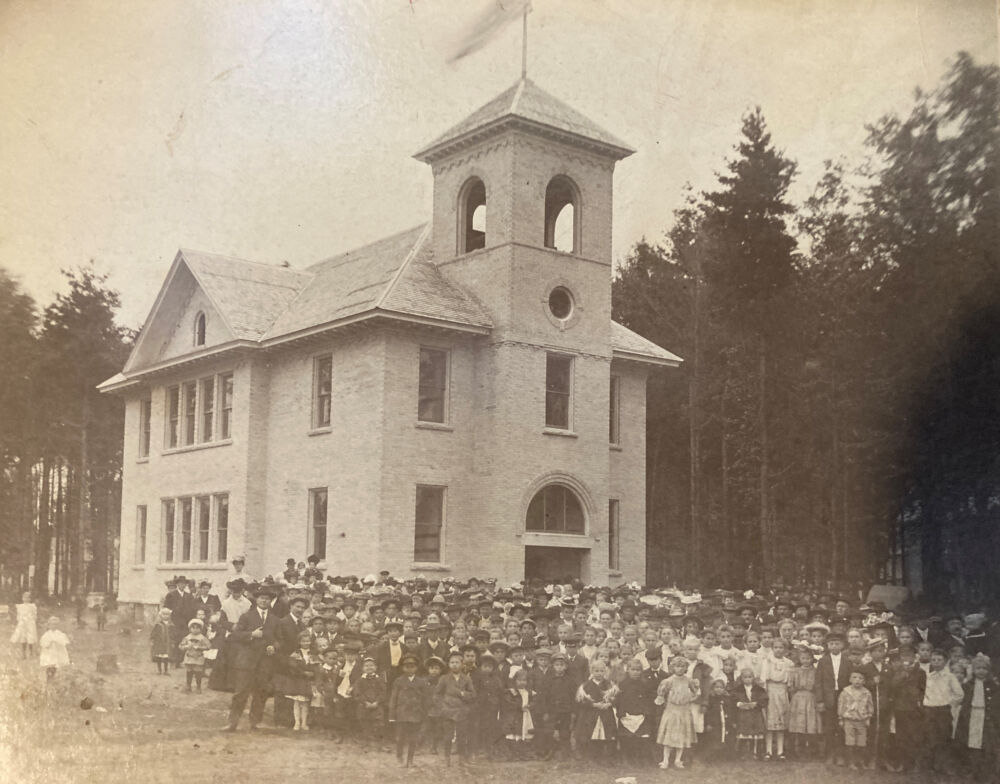
SAINT JAMES LUTHERAN SCHOOL
St. James Lutheran School was organized in 1889 by Pastor Theodore Nicke! who also served as the first teacher, instructing pupils in his home on Union Street, one block south of Green Bay Street. In 1890 the congregation erected its first school building, which consisted of one large classroom. Pastor Nickel taught until 1898 when the first full-time teacher, Mr. H. Gehner was called. At that time 59 pupils were enrolled in the school.
In the fall of 1907 a two-room school was built on the site occupied by the present school. One hundred and ten pupils were enrolled and Teacher Gehner was assisted by various pupils. In 1909 Mr. B. F. Koepsell was installed as the second called teacher in the school and St. James became affiliated with the Lutheran Church – Missouri Synod. Enrollment increased rapidly and 186 pupils were enrolled by 1916. In 1917 Mr. A. J. Felton assumed the duties of principal. The school was enlarged to four classrooms in 1920 and a teacherage was erected. By 1928 the congregation for the first time in its history had three called teacher with the installation of Mr. E. H. Rupprecht in 1927 and Mr. E. A. Albers in 1928.
Disaster struck on April 12, 1936 when the school building was nearly completely destroyed by fire. Almost immediately the congregation resolved to erect a new structure and on February 7, 1937 the new school building was dedicated, which is the center of the present school structure.
Mr. Walter Gerdes was called as teacher in 1942 and became principal in 1943 when Mr. Felton accepted a call.In the fall of 1948 enrollment warranted a separate room for each grade and two classrooms were held in the church basement. On April 27, 1952, three modern classrooms and a completely equipped Kindergarten classroom (the south portion of the present structure) were dedicated and school enrollment reached 360 pupils taught by nine teachers. The kindergarten was started in 1950 with Mrs. Edward Reichel as the first Kindergarten teacher.
Mr. W. E. Jiede, called as teacher in 1948, became principal in 1956 when Mr. Gerdes accepted a call. In 1960 a large building program added 7 classrooms, a principal’s and secretary’s office, faculty lounge, multi-purpose meeting room, and a spacious activity center. This complex, added to the north and east of the original structure, was built for $350,000.
In 1965 Mr. Jiede, chose to enter the preaching ministry and Mr. Hilbert Handrich served as acting principal for a year until Mr. Wilbur Kleinschmidt assumed the position as principal in July 1966. The school reached an all-time enrollment of 502 pupils taught by seventeen staff members in September, 1972.
St. James School has been active in community outreach through participation of its teachers in various organizations and through activity in in-cooperating community business and leaders into the curriculum and through student visitation with special emphasis given to rest home ministry

